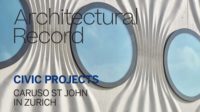Among the many challenges to building, a difficult site poses one of the most daunting. For a social housing complex in Paris’s hilly 20th arrondissement, in the northeast part of the city—a rapidly transforming formerly working-class neighborhood—Bruther, a 2017 Record Vanguard firm, faced a particularly unusual spot. “It wasn’t obvious what to put there,” says Bruther cofounder Alexandre Theriot. The architects were confronted with a narrow, irregularly shaped lot that opened onto two streets—Rue Pelleport, a major road that runs through much of the precinct, and Rue des Pavillons, a winding street that descends to the west. Then there’s context. On one side of the tight site was an overwrought tower from the 1990s by Frédéric Borel, known in France for his deconstructivist architecture; on the other, a tall, nearly 400-foot-long housing block from the 1970s. A limited budget—just over $200 per square foot, typical for this type of project, where rents are often a fraction of market rate—left Bruther with a triple whammy. To build anything at all would be an achievement; that it turned out so well, an exceptional one.
Additional Content:
Jump to credits & specifications
Bruther won the competition for the Pelleport housing—their first win—back in 2009, shortly after the husband-and-wife team of Theriot and Stéphanie Bru formed the Paris-based practice. They’ve since completed several award-winning buildings in Paris and elsewhere in France while construction on this project was stalled due to legal battles initiated by opponents to the building, which houses low-income and formerly homeless residents.
The stripped-down aesthetic and minimal material palette for which Bruther has become known works extremely well here. Vast expanses of glass and corrugated aluminum define the poured-concrete structure, giving it an ethereal, almost transparent quality. Yet it is not intimidated by its imposing neighbors. Instead, the highly articulated building asserts itself as an antidote to the respectively pompous and behemoth forms on either side.
Though actually one building—connected by a three-story bridge-like structure, containing a series of small studios under 300 square feet apiece—it appears as two separate, triangular- shaped ones facing a modest courtyard in the middle and delicately hinged between neighbors. Along Rue Pelleport, the larger of the two structures presents a jagged, see through facade comprising pivoting glazed shutters that enclose winter gardens for the apartments on the upper levels. A commercial space occupies the ground floor.
Along Rue des Pavillons, where grade drops a full story due to the slope of the side street, a smaller structure, more in scale with the low-rise buildings around it, features—like the rear of the Pelleport structure looming in the background—balconies with manually adjustable awnings. As an ensemble, the multiple faces of the building, including the pivoting winter-garden shutters, offer dynamic, constantly changing surfaces. On Rue des Pavillons, this is further enhanced with color. Bruther selected an array of paint and curtain hues for the rooms along the balconies, which the majority of tenants have maintained since moving in late last year. “It is an easy and inexpensive way to add atmosphere and a personal touch,” says Theriot.
The largest of the 25 living units—most of which have access to their own outdoor space, whether winter garden or balcony—are 900-square-foot three-bedroom apartments. While finished very simply, they feel ample in size. Exposed raw concrete columns and beams—not always lined up as you’d expect them to be—define spaces and serve as strong architectural accents in the basic but light-filled interiors, which offer variegated spatial qualities because of the unusual geometry of the plan (arrived at partially by zoning and partially for views) and steep roof pitch (on the larger structure). The all-gray hallways and tiled lobby, rather than feeling oppressive, are unexpectedly pleasing, tying in with finishes in the rest of the building to offer clean, bright public areas.
It’s frequently said that constraints help the design process. In this case, facing acute site and budget limitations, Bruther pulled off an impressive piece of architecture, not only for its commanding street presence but also for its generous accommodations—many with expansive views over the heart of Paris—in a building type that all too often is considered less worthy of such.
CreditsArchitect: Bruther—Stéphanie Bru, Alexandre Theriot, principals
Engineering: Louis Choulet (environmental); EVP (structural)
General contractor: SBG Lutèce |
SpecificationsGlass Saint-Gobain
Metal panels Tolartois |















Post a comment to this article
Report Abusive Comment